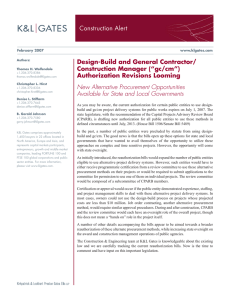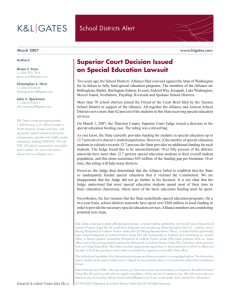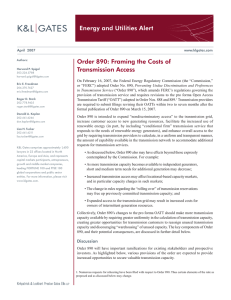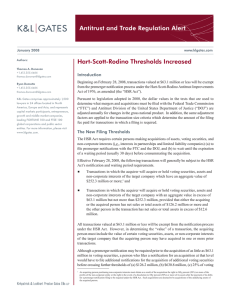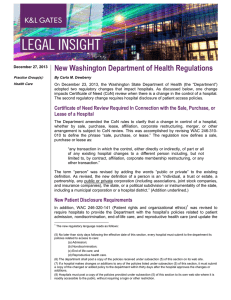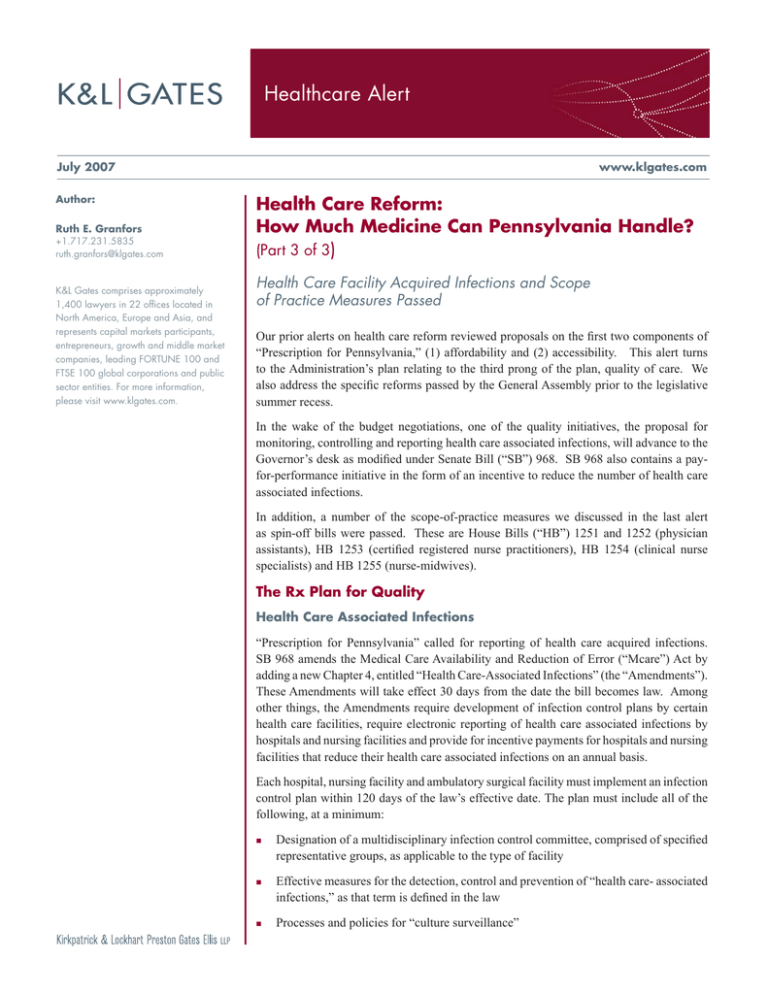
Healthcare Alert
July 2007
Author:
Ruth E. Granfors
+1.717.231.5835
ruth.granfors@klgates.com
K&L Gates comprises approximately
1,400 lawyers in 22 offices located in
North America, Europe and Asia, and
represents capital markets participants,
entrepreneurs, growth and middle market
companies, leading FORTUNE 100 and
FTSE 100 global corporations and public
sector entities. For more information,
please visit www.klgates.com.
www.klgates.com
Health Care Reform:
How Much Medicine Can Pennsylvania Handle?
(Part 3 of 3)
Health Care Facility Acquired Infections and Scope
of Practice Measures Passed
Our prior alerts on health care reform reviewed proposals on the first two components of
“Prescription for Pennsylvania,” (1) affordability and (2) accessibility. This alert turns
to the Administration’s plan relating to the third prong of the plan, quality of care. We
also address the specific reforms passed by the General Assembly prior to the legislative
summer recess.
In the wake of the budget negotiations, one of the quality initiatives, the proposal for
monitoring, controlling and reporting health care associated infections, will advance to the
Governor’s desk as modified under Senate Bill (“SB”) 968. SB 968 also contains a payfor-performance initiative in the form of an incentive to reduce the number of health care
associated infections.
In addition, a number of the scope-of-practice measures we discussed in the last alert
as spin-off bills were passed. These are House Bills (“HB”) 1251 and 1252 (physician
assistants), HB 1253 (certified registered nurse practitioners), HB 1254 (clinical nurse
specialists) and HB 1255 (nurse-midwives).
The Rx Plan for Quality
Health Care Associated Infections
“Prescription for Pennsylvania” called for reporting of health care acquired infections.
SB 968 amends the Medical Care Availability and Reduction of Error (“Mcare”) Act by
adding a new Chapter 4, entitled “Health Care-Associated Infections” (the “Amendments”).
These Amendments will take effect 30 days from the date the bill becomes law. Among
other things, the Amendments require development of infection control plans by certain
health care facilities, require electronic reporting of health care associated infections by
hospitals and nursing facilities and provide for incentive payments for hospitals and nursing
facilities that reduce their health care associated infections on an annual basis.
Each hospital, nursing facility and ambulatory surgical facility must implement an infection
control plan within 120 days of the law’s effective date. The plan must include all of the
following, at a minimum:
Designation of a multidisciplinary infection control committee, comprised of specified
representative groups, as applicable to the type of facility
Effective measures for the detection, control and prevention of “health care- associated
infections,” as that term is defined in the law
Processes and policies for “culture surveillance”
Healthcare Alert
Identification and designation of patients and
residents who are “colonized” with a drugresistant organism (MRSA or MRDO, as those
terms are defined in the law); these identification
procedures are to include cultures and other
screenings upon admission to a hospital
Protocols for follow-up tests and treatment of
staff who may have been exposed to a patient
or resident colonized or infected with MRSA or
MRDO
A process for notification before transfer of
colonized patients or residents within or between
a hospital, nursing facility or ambulatory surgical
facility
An infection-control intervention protocol,
including, among other things, surveillance,
isolation and treatment procedures; physical
plant standards; and fiscal and human resource
requirements
A system for distributing infection-control
advisories for all administrative and health care
personnel and medical staff
The Department of Health (“DOH”) must review the
infection control plan within 14 days of implementation
of the plan. If DOH finds that the plan is not in
compliance with any applicable law, the facility must
modify the plan appropriately. The health care facility
will be responsible for policing employee and medical
staff compliance with its plan. The Amendments
mandate private and Medical Assistance (“MA”)
reimbursement for the cost of cultures and screenings
performed in compliance with the facility’s infection
control plan. MA reimbursement on this point is
subject to federal approval.
Nursing facilities will be required to electronically
report health care associated infections to the Patient
Safety Authority (“Authority”) as a serious event under
section 302 of the Mcare Act. Nursing facilities will
also be required to make such reports to DOH. The
Authority will be responsible for establishing uniform
definitions for identifying and reporting health care
associated infections. The Authority and DOH will
determine the format and timing for reporting, which
is to be published by the Authority as a Notice in the
Pennsylvania Bulletin. Prior to publishing the Notice,
the Authority is required to give nursing facilities at
least 30 days to comment on the required reporting
procedures. The date to begin reporting must be
no less than 120 days following publication of the
Notice.
Hospitals currently report health care associated
infections to the Health Care Cost Containment
Council (“Council”) and the Authority. Under the
Amendments, hospitals will be required to report
such infections instead to the National Healthcare
Safety Network (“NHSN”) of the Centers for Disease
Control (“CDC”) in accordance with the procedures
of the NHSN. Information about the NHSN and its
procedures can be located on the NHSN website:
http://www.cdc.gov/ncidod/dhqp/nhsn.html.
Hospitals will need to authorize access to their NHSN
data by the DOH, the Authority and the Council.
Until the new reporting process is in place, hospitals
will continue to report infections to the Authority
and the Council as in the past. The Authority will
be responsible for publishing through Notice in the
Pennsylvania Bulletin the date by which reporting
to the NHSN must occur, which date must be no
sooner than 120 days after publication of the Notice.
Hospitals must be given an opportunity to comment
on the Notice before it is published.
With respect to hospitals, theAmendments also mandate
the use of a “qualified electronic surveillance system”
by December 31, 2008 for the prevention, detection,
and control of health care associated infections. An
exception is made for hospitals that conduct a strategic
assessment by December 31, 2007, in accordance
with the Amendments, and determine that it is not
technically or financially feasible to implement
such a system. A “qualified electronic surveillance
system” must include: (1) the ability to extract clinical
data on an ongoing, constant and consistent basis;
(2) translation of data from the laboratory, radiology
and pharmacy operations into uniform information
that can be analyzed on a population-wide basis;
(3) the infrastructure (clinical support, educational
tools and training) to assure that the system will
produce information capable of reducing health care
associated infections to meet or exceed benchmarks;
(4) clinical improvement measurements that can be
used to provide feedback to infection control staff; and
(5) the ability to collect patient-specific data across the
July 2007 | 2
Healthcare Alert
entire facility. Hospitals that determine they cannot
implement a qualified electronic surveillance system
by December 31, 2008, must implement an interim
surveillance system that meets minimum requirements
set forth in the Amendments until they can implement
a qualified electronic surveillance system. Unless a
hospital already has in place a qualified electronic
surveillance system, all other hospitals must meet
the interim requirements for a surveillance system
(after performing the strategic assessment) until
implementation of a qualified electronic surveillance
system by December 31, 2008. DOH is to review each
strategic assessment and assist with implementation
of a qualified electronic surveillance system.
DOH also is required to develop a methodology,
through consultation with the Authority and the
Council, to determine rates of health care associated
infections and set the benchmarks from which
performance may be judged. The DOH will publish
the benchmarks in the Pennsylvania Bulletin, but shall
seek comment on the proposed benchmarks first and
shall respond to the comments it receives during a
30-day comment period. Beginning January 1, 2009,
hospitals and nursing facilities will be eligible for an
incentive payment, subject to available funds, if they
reduce the number of facility infections annually by
the established percentage. The Department of Public
Welfare will administer the incentive payments. By
2010, all hospitals and nursing facilities will be subject
to meeting the benchmarks as part of the licensure
requirements under the Health Care Facilities Act,
including development of plans of correction and
assessment of penalties under that Act, if necessary.
Other Quality Proposals Still in the Idea
Stage: E-Prescribing
HB 700, the Administration’s health reform bill,
also proposes under its quality initiatives the use of
electronic prescribing by most health care facilities
and all physicians. The bill would require all
hospitals, nursing facilities, birthing centers and
ambulatory surgical facilities to develop a “full
and complete implementation plan with specific
goals, key performance indicators and timelines”
concerning a universal e-prescribing system for all
employees and contractors who have prescriptive
authority. These health care facilities would have to
certify implementation of the system to the DOH on
licensure renewal applications. In addition, the Board
of Medicine would need to determine a date by which
all licensed physicians will be required to use an
e-prescribing system. The physicians would be
required to certify such access and use as a condition
of licensure. False or misleading information provided
by a health care facility or physician to its respective
licensing agency would be subject to a $5,000 fine.
SB 14 and HB 1683 were introduced in June and
July, respectively, to address these same e-prescribing
requirements under stand-alone bills. Although these
bills did not move before the legislative recess, they
may become the next step in reform later this year.
Implementation through Executive
Orders
Governor Rendell has announced the intention to
implement portions of Prescription for Pennsylvania
through a series of Executive Orders. The Governor
began this process on May 21, 2007, with another
quality initiative when he issued Executive Order
2007-05, establishing the Chronic Care Management,
Reimbursement and Cost Reduction Commission (the
“Commission”). The Commission has no regulatory
power and no enforcement authority, but it is charged
with developing and encouraging the use of best
practice models for chronic disease management by
clinicians and patients. The Administration has placed
initial emphasis for this Commission on diabetes
management.
Other initiatives are also to be created by Executive
Order, including an alleged issuance on approval of
major capital expenditures. It is anticipated that such
Executive Orders will establish new statewide or local
commissions that perform an advisory or consultation
function as opposed to a regulatory role since an
Executive Order does not have the force of law.
Scope-of-Practice Laws
Five of the eight scope-of-practice bills introduced
in the House and the subject of our last health
reform alert (http://www.klgates.com/newsstand/
Detail.aspx?publication=3863) also were passed by the
General Assembly, with some amendments. Physician
assistants, certified registered nurse practitioners,
clinical nurse specialists and nurse-midwives are all
affected. Reforms regarding dental hygienists also
July 2007 | 3
Healthcare Alert
passed, but not in the House Bill version. Instead, SB
455 advanced to the Governor’s desk for signature.
The bills on pharmacists and nurse anesthetists did
not pass.
stakeholders will need to follow these individual and
competing developments to make certain that their
concerns are represented and to understand how the
new laws will affect them.
Notably, HB 1251 and HB 1252, addressing physician
assistants under the State Board of Medicine and the
State Board of Osteopathic Medicine (the “Board”),
amended the provision that would have placed no
limitations on the number of physician assistants under
a physician’s supervision to setting a limit of four, up
from the current limit of two. The Board is authorized
to grant waivers of this limit to allow physicians to
supervise more than four individuals.
Information about “Prescription for Pennsylvania”
can be found on the Governor’s Office of Health
Care Reform website: www.rxforpa.com. House Bill
700 and other legislative proposals can be found at:
http://www.legis.state.pa.us/.
SB 455 creates a “public health dental hygiene
practitioner” who may practice independently in
specified settings set forth in the law or where the
Dental Board would deem to be appropriate. These
settings include, but are not limited to, schools, health
care facilities (as defined in the Health Care Facilities
Act), personal care homes and adult daily living
centers.
Tracking Rx for PA Developments
Governor Rendell’s “Prescription for Pennsylvania”
and House Bill 700 spawned a number of new bills
and legislative discussion on health care reform.
Although introduced as a proposal interlocking
accessibility, affordability, quality and cost as one
program, splinter legislative initiatives have emerged
and become law. These smaller, issue-based actions
will form the basis for health care reform. Interested
Questions about health care reform proposals in
Pennsylvania or compliance with the new legal
mandates may be directed to:
Public Law and Policy Practice:
Peter A. Gleason 717.231.2892
peter.gleason@klgates.com
Raymond P. Pepe 717.231.5988
raymond.pepe@klgates.com
James D. Welty 717.231.5878
jim.welty@klgates.com
Health Care Practice:
Ruth E. Granfors 717.231.5835
ruth.granfors@klgates.com
Patricia C. Shea 717.231.5870
patricia.shea@klgates.com
Edward V. Weisgerber 412.355.8980
ed.weisgerber@klgates.com
K&L Gates comprises multiple affiliated partnerships: a limited liability partnership with the full name Kirkpatrick & Lockhart Preston Gates Ellis
LLP qualified in Delaware and maintaining offices throughout the U.S., in Berlin, and in Beijing (Kirkpatrick & Lockhart Preston Gates Ellis LLP
Beijing Representative Office); a limited liability partnership (also named Kirkpatrick & Lockhart Preston Gates Ellis LLP) incorporated in England
and maintaining our London office; a Taiwan general partnership (Kirkpatrick & Lockhart Preston Gates Ellis) which practices from our Taipei
office; and a Hong Kong general partnership (Kirkpatrick & Lockhart Preston Gates Ellis, Solicitors) which practices from our Hong Kong office.
K&L Gates maintains appropriate registrations in the jurisdictions in which its offices are located. A list of the partners in each entity is available
for inspection at any K&L Gates office.
This publication/newsletter is for informational purposes and does not contain or convey legal advice. The information herein should not be used
or relied upon in regard to any particular facts or circumstances without first consulting a lawyer.
Data Protection Act 1998—We may contact you from time to time with information on Kirkpatrick & Lockhart Preston Gates Ellis LLP seminars
and with our regular newsletters, which may be of interest to you. We will not provide your details to any third parties. Please e-mail london@
klgates.com if you would prefer not to receive this information.
©1996-2007 Kirkpatrick & Lockhart Preston Gates Ellis LLP. All Rights Reserved.
July 2007 | 4


